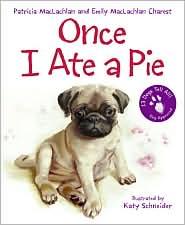 BIBLIOGRAPHY
BIBLIOGRAPHYMacLachlan, Patricia and Emily MacLachlan Charest. 2006. Once I Ate a Pie. Illus. by Katy Schneider. NY: Joanna Cotler Books (HarperCollinsPublishers). ISBN: 9780060735319.
SUMMARY
From their point of views, thirteen poems highlight the fun, loving and mischievous life of dogs.
CRITICAL ANALYSIS
In this charming series of thirteen poems, authors Patricia MacLachlan and Emily MacLaclan Charest has written thirteen free-verse poems that truly capture the humorous personalities of dogs. Abby “borrows” not steals. Lucy was adopted from a shelter and now calls the couch, chairs, bed, and pillow hers. A pug named Mr. Beefy likes to eat butter and admits that he once ate a pie. The German Shepard, Gus, likes to herd his people. The age of the dogs range from puppies like the poem “Puppy” at the beginning of the book:
The world is big
Trees too tall.
Sky too HIGH.
Snow over my head.
What if I get lost?
“You will chase snowflakes in winter,” the people tell me.
“Run through the grasses in spring
and howl at the full moon."
Not now. I am a puppy.
For now I will stay here
by your side
safe.
Warm.
Puppy.
To dogs in the prime of their life and finally the books ends with the poem Luke, the old St. Bernard who likes to sleep and dream of when he was young, but he will bark when he wants and will howl at the moon at night.
Through the effectiveness of the how the poems portray the personalities and behaviors of the dogs, the readers truly get the feeling of the what the dog is like. A wonderful example is Mr. Beefy’s poem:
I am not thin, but I am beautiful.
When no one is looking, I steal tubs of butter off the table.
I take them to the basement to eat in private.
Once I ate a PIE.
The reader cannot help but read this poem with a deep voice and with a passion, especially at the end with the admittance of once eating a pie.
Each poem is presented in a double-page spread with most illustrations in flowing onto both and with the poem itself in the white space. The poems are structured in a fun and appealing way. The emphasize a specific word to further illustrate the personality of the dog the text is larger or tinier than the normal size font and are sometimes in bold print. Words and lines also break free of the regular straight right to left some are written in waves or scattered about, which also shows the personality of the dog, for example, the poem for the dog Needle Nose who likes to get into everything the words of the poem begin to scatter as it describes what he likes to get into, “the refrigerator/the dishwasher/quilts/pillows/dog-cookies boxes/cat-snack bags/toys–I like the squeaker.”
All the poems are great to share with one reader. However, there are also poems that children can help in reading. For example, the poem “Louis” about a little Pomeranian who use to yip but now barks, there is a refrain of “I BARK” that the children can repeat while one reads. There is also the poem for the dogs Tillie and Maude, who are two dogs that look alike but have different personalities and behaviors. The poem is presented in a double page spread, Tillie’s part of the poem is on one page and Maude’s part of the poem is on the second page. This poem is a wonderful opportunity to have two readers read the poem.
Schneider’s oil paint illustrations are wonderfully artistic and complement the free-verse poems. The breeds of the dogs are lovingly and accurately presented. The personalities that are seen in the poems are also emulated in the faces and body language of the dogs in the illustrations. For example, the puppy Wupsie says her name is Wupsie but people call her “cute” be cause she covers her eyes with her pays and pretends to sleep. The illustration for the puppy shows her on her back, paws curled and her tongue playfully handing out of her mouth. Another example is Sugar, who sleeps all the time, unless she chases the cat, the illustration shows her in three different sleeping positions.
Once I Ate a Pie is a wonderful and loving book about man’s, woman’s, and child’s best friend that is perfect for any school, public, and personal library. Share this poem all year long and especially during the American Humane Association’s Adopt-a-Dog Month of October.
CONNECTIONS
*Bring pictures or books of different types of dogs or have children who have dogs at home bring a picture and have the children pick a breed and allow them to write a poem about them. Let the imagine run and let them create a personality for the dog and have them write a poem about them, as in the books.
*Have fun reading the poems aloud. Have two children read the poem “Tillie and Maude” (one child per dog) and have the children help you say the refrain “I BARK” in the poem “Louis.”
*Read more poetry books about dogs like: Dogku by Andrew Clements and illus. by Rim Bowers, Dog Poems by Dave Crawley and illus. by Tamara Petrosino, and Good Dog by Maya Gottfried and illus. by Robert Rahway Zakanitch.
*Have the children find out what the breeds are of the dogs that are seen in the books.
No comments:
Post a Comment
Thank you for visiting, WP-CC! Please leave a comment!